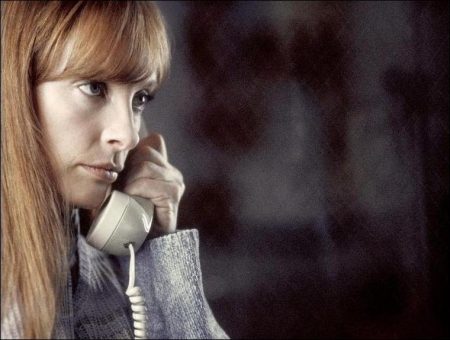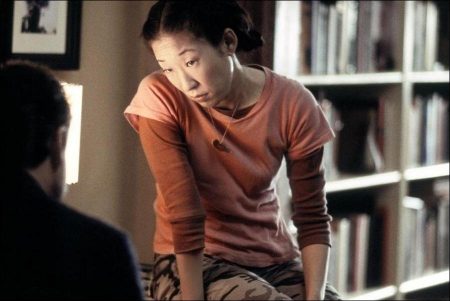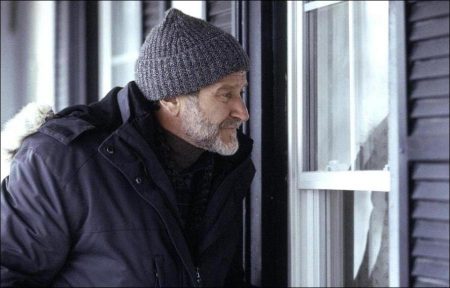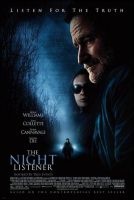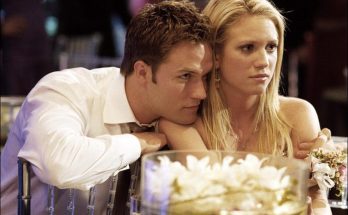Tagline: Listen for the truth.
Gabriel Noone is a late night radio-host in a big city, specializing in spooky tales culled from his active imagination. When Gabriel’s lover decides he needs some “space” and moves out, Gabriel descends into a funk until a publisher friend brings him a manuscript written by 14 year-old Pete Logand, a troubled young fan. Pete’s story touches the vulnerable Gabriel deeply. Pete was severely abused by his parents and is now under the care of his former social worker, Donna Logand, who has adopted him. Pete is very ill and he and Donna are keeping a low profile in a small town in Wisconsin to avoid discovery by Pete’s mother.
Gabriel develops an unsettling long-distance telephone relationship with the boy and his guardian. Nothing is as it seems and the skepticism of friends causes Gabriel to become suspicious of Donna and her motives, so he tries to resolve the loose ends by traveling to Wisconsin to confront Donna and Pete. But this effort is largely unsuccessful and we are left wondering if Pete is real, if Donna is really blind or if Gabriel is the deranged soul of the story.
“Night Listener” tackles the narrative of Armistead Maupin’s most haunting page-turner, in which popular public radio storyteller Gabriel Noone (Robin Williams) develops an intense phone relationship with a young listener named Pete (Rory Culkin) and the social worker who rescued him from a life of abuse (Toni Collette). But Gabriel soon comes to the startling realization that it is quite possible that neither the boy nor his painful account of his childhood really exist.
The Night Listener is a 2006 psychological thriller film directed by Patrick Stettner. The screenplay by Armistead Maupin, Terry Anderson, and Stettner is based on Maupin’s 2000 novel The Night Listener, which was inspired by Anthony Godby Johnson. The film premiered at the Sundance Film Festival and was shown at the Berlin International Film Festival before opening on 1,367 screens in the US, earning $3,554,134 in its opening weekend. The film went on to gross $7,836,393 domestically and $2,785,502 in foreign markets for a total box office of $10,621,895.
About the Production
A haunting, suspense-filled mystery about truth, lies and storytelling, The Night Listener follows the disturbingly eerie twists and turns that unfold in the relationship between a popular late-night radio host and a devoted young fan who claims to have survived a terrifying, secret past.
“The facts can always be altered when you’re telling a story, but this time, I have to be careful. I’ll lay out the events exactly as I remember them. I want you to believe this, after all, and that will be hard enough as it is.”– Gabriel Noone
Robin Williams stars as Gabriel Noone, a colorful public radio storyteller who, in the throes of his own emotional crisis, begins talking on the phone with a precocious, 14 year-old listener named Pete (Rory Culkin), a boy with his own incredible story to tell about a nightmare childhood.
Still reeling from a devastating breakup with his lover of ten years (Bobby Cannavale), Gabriel finds unexpected comfort in his long-distance conversations with Pete and begins to support him in the publishing of his memoirs. But as Gabriel draws closer to Pete and his adopted mother (Toni Collette), becoming a kind of surrogate father, he also grows more and more filled with doubts about the boy’s tales and macabre suspicions over who he really is – sparking a desperate, quest to uncover the elusive truth.
A Thriller of the Heart
A runaway hit with critics and readers alike, Armistead Maupin’s novel The Night Listener seemed to defy categorization. It is at once a layered, Hitchcockian mystery that kept readers guessing, an intimate personal saga about the longing for romantic and family love, as well as a riveting meditation on why we concoct stories, who we tell them to and how their effects resonate through our lives. Maupin himself called the novel “a thriller of the heart,” and admitted that it was partially auto-biographical – largely inspired by an extraordinary, unsettling true-life chain of events that actually happened to Maupin and his ex-partner, Terry Anderson, back in 1992.
It was then that Maupin, the celebrated author of the popular Tales of the City serial novels (which also became an acclaimed television mini-series), was sent a manuscript by a 14 year-old boy who claimed to have survived shocking physical and sexual abuse as a child, and had just penned a heartfelt memoir as a way of healing from his nightmare.
Maupin was so taken by the boy’s tale of endurance, he wanted to speak directly with him – and so began an extended long-distance phone friendship with this remarkably wise child and his very protective, adopted mother. Yet one day, after months of camaraderie, Terry Anderson pointed out to Maupin that the boy’s voice and his mother’s voice were disturbingly similar. Realizing Anderson was right, Maupin began to doubt the boy’s very existence. The author’s questioning mind went into overdrive: Who was the boy really? Who exactly had written the memoirs? Was any of what he said true? And if not, why would someone create such a lavishly bizarre deception… and why did Maupin want so badly to believe in it?
Maupin feared harming the boy if his suspicions were wrong, so he continued his friendship in spite of his deepest misgivings. While the real-life mystery persisted (and eventually became the subject of a haunting but inconclusive article by Tad Friend in The New Yorker), Maupin’s imagination continued to spin. He began to see the threads of a literary thriller that could be woven around the very question of human identity itself.
Says Maupin: “I realized that I had stumbled on the most fascinating story of my life — that I was actually living a novel. I was in the middle of a mystery which delivered to me something that I’d always wanted to write. I’ve always loved the notion of a thriller that’s not built around murder, or larceny, or violence, but rather the mystery of the human heart, and that became The Night Listener. It’s about the question of how do we love, what do we become obsessed with, what do we long for – and most of all, how are we blinded by those things? I think they’re the most fascinating mysteries of all.
The Night Listener Comes to the Screen
Once published, Maupin’s novel instantly drew fans around the world – among them film producer Jeff Sharp of Hart Sharp Entertainment. Already a fan of Tales of the City, Sharp was excited to read The Night Listener – and stunned to discover it was something completely different from what he expected. He was convinced the story, with all its human enigmas and sudden surprise twists, had all the elements to make for a smart, cinematic thriller. Furthermore, with today’s headlines filled with real-life tales of a writer’s deceptions and the messy lines between fact and fiction, the story seemed to be that rare mystery with the potential to provoke fear and thought simultaneously.
Says Sharp: “I found the novel to be a real page-turner, a rich and accomplished work, and the best combination of Armistead’s talents yet. You fall in love with the characters, but they take you to a very dark place – and a place where I don’t think Armistead has ever gone before. It’s a love story intertwined with the thrill ride of a mystery. We saw it as a great opportunity to create a compelling, character-based thriller.” Adds producer Robert Kessel, succinctly: “It’s a story you just can’t get out of your head.”
The story also seemed to fit right in with their company’s style. “The stories that are most difficult to translate to screen are the ones that always seem to inspire us the most,” notes Hart. “That’s our calling and has been since BOYS DON’T CRY, which is similar to THE NIGHT LISTENER in its provocative nature, its darkness and its true-story overtones.”
Inspired by the knowledge that Maupin is an obsessive movie lover, Hart Sharp approached the author about adapting his novel for the screen. Maupin was more than thrilled. He saw it as a chance to revisit his work and do something entirely new with it. “I like the idea of adding fresh mysteries to the story, of underlining the themes in new ways and to keep people guessing even more,” says Maupin.
Before he dove in, however, Maupin made a bold decision: to collaborate on the screenplay with his ex, accomplished writer Terry Anderson. “My feeling was that because Terry had lived this story with me and had been the person who’d originally pointed out the deception, he should be a part of this process,” explains Maupin. “He’s also a guy with a lot of great ideas.”
But both men were prepared for an emotional ride. “Terry and I knew that we were in for something of a rocky road writing a screenplay based on the novel that had to do with our breakup,” admits Maupin. “Writing about two characters who are really us was a bit surreal, but of course that’s the whole process of fiction – to draw from the emotional truth of your life.
That elusive border between the real and the unreal is constantly breeched in THE NIGHT LISTENER, creating a mind-bending effect, even for the writers. Says Terry Anderson: “We were constantly dancing on the fine line of what was really happening and what wasn’t.”
He continues: “The process of going from a real life story that was translated into a novel and taking it into another fictional form for film was a big challenge, especially because so much of the story is about what happens on the phone. Phone conversations don’t often work that well on film so we had to look for a lot of devices to make it more visually exciting – taking you deeper into the characters’ worlds and making it more dramatic and fun. At the same time, we faced the challenge of putting some distance between the real-life events that happened to us and the story on the screen.”
While Maupin and Anderson grappled with reality and illusion, the producers began to search for a director who could bring a fresh but skilled eye to this dark, mysterious territory. They found what they were looking for in rising newcomer Patrick Stettner, who came to the attention of Hollywood when he wrote and directed THE BUSINESS OF STRANGERS, a sly satire of corporate life, starring Julia Stiles and Stockard Channing as two businesswomen who seek revenge on an abusive corporate headhunter.
“Patrick immediately caught my eye when THE BUSINESS OF STRANGERS was released,” says producer Robert Kessel. “That movie demonstrated that he could really create a mood, a feeling of suspense with elements of fear. What he did with that movie felt very different from what most of his peers were doing.
It took Stettner one read of an initial draft of THE NIGHT LISTENER, and he knew it was his next project. “What attracted me to the story was that it was so suspenseful, but with great characters and so many unusual themes percolating beneath the surface,” he says. “Among other things, this film is about the art of storytelling and the importance that stories have in our lives, and how one person takes that art to an extreme. I love this notion that if the purpose of art is to aspire to communicate what it’s like to be human — then this is what Donna does in a very real way. Through her voice she creates this physical manifestation – this complete, tragic boy – that becomes this incredible vehicle of sympathy and love.
He quickly developed his own strong vision of the film as a probing psychological thriller – then spent the next year and half intensively focusing on the screenplay and taking it through numerous revisions. “I knew that I wanted to build the suspense of the story with a subtle lurking quality, so that the audience doesn’t know from which direction the threat is going to come, almost like an undertow pulling beneath them,” he explains. “I wanted there to be an unconscious, seamless quality to the tension that would come from the whole psychological landscape rather than from any single plot device. And I also wanted to have some subjective shots creep in, giving the audience the sense that the voyeur, if you will, is also being watched.”
Stettner focused his increasingly tighter and tighter screenplay drafts on Gabriel’s journey, paring down the various storylines and finding new ways to heighten the tension. His process was intense and personal. He recalls: “At one point during this lengthy process, I wanted to better understand Donna’s character, the idea of getting love and sympathy via a phone call was key to understanding the story. It fascinated me. One night, I called a suicide hotline pretending I was going to kill myself. It was an invaluable experience. I was immediately struck by this jolt of unconditional love I got from the hotline operator – that person cared, told me I was good, that I had worth. It was an incredibly intimate connection between two complete strangers. So much so that I quickly became embarrassed, told her I was better and quickly hung up. But that amazing connection gave me real insight into the story.”
Maupin and Anderson were delighted with Stettner’s contributions, especially because he brought a fresh point-of-view to a story they had been living with and thinking about for a decade. “The novel and the final screenplay are truly divergent,” Anderson notes. “As Patrick got involved, he started seeing things that we couldn’t possibly have seen because we were so close to it. In the film, Gabriel’s journey is much larger, his trials are much greater and the things he gets into are much spookier. The process of working with a director driven by such a strong vision was terrific.”
Stettner also enjoyed having such creative collaborators on his side. “Working with Armistead and Terry was great and very fluid because they’ve both seen a lot of films and we all had the same objective, to make the best possible movie,” he says. “Generally, I would go away to write a draft, then send it to Armistead and Terry. I’d get their notes on the phone and then retool it. Sometimes if I knew I didn’t really nail a scene, we would all work together on the scene. It was a wonderful, creative relationship the whole way.”
But Stettner knew that, for him, the screenplay would not truly be complete until he began working with the film’s actors.
“For me, the final step in shaping and understanding the script always comes during rehearsals with the actors,” he explains, “because it’s only then, when I see a scene on its feet with actors, do I truly understand the potential of a scene. Immediately, I start to eviscerate the dialogue, finding character detail that can be said visually within the performance. I am constantly looking for subtext. And I strongly believe in that old adage that language in drama is used to hide the truth. Especially in this film, I always looked for that underlying tension between what characters are feeling and what they are actually saying.”
A Storyteller Deceived by A Story
At the heart of THE NIGHT LISTENER is Gabriel Noone, host of “Noone at Night,” a late-night talk show on which he has become famous for sharing stories from his life – mostly true but sometimes “embellished” — across the air waves of America. Now, just as Noone’s personal life seems to be falling apart, he finds himself drawn into a mysterious relationship with a family that may be a complete and utter fiction – a relationship that will test everything in which he believes and rend the very fabric between truth and illusion.
When it came to casting Gabriel, the filmmakers knew they needed someone with enough wit and force of personality to be believable as a radio star – yet also the ability to delve into the darkest zones of the human psyche. “Our first choice was always Robin Williams, and he brings a whole world of emotion to this character,” says John Hart. “Robin creates characters in a way I don’t think anyone else does. We also knew he could do this because, as in GOOD MORNING VIETNAM, Robin reaches out over the radio and tells stories, and as in ONE HOUR PHOTO, his character deals with a powerful obsession that drives him to extreme actions.”
Adds Patrick Stettner: “So much of this film hinges around the fact that Gabriel actually goes on this impossible journey to find this boy. We needed an actor who could play Gabriel with a big, clumsy heart, someone sympathetic, someone you almost felt cared too much. It’s not an easy quality to find in a leading man and I thought Robin was perfect for the role. When you look at his work in GOOD WILL HUNTING and THE WORLD ACCORDING TO GARP, you know he is capable of delivering this kind of beautiful, subtle performance.”
Williams, a long-time resident of San Francisco, also already had a friendship with Armistead Maupin. “They all live in San Francisco and have known each other for almost 30 years. So Terry Anderson hopped on his bike and rode over to their office and dropped off a copy of the script,” recalls Kessel.
Adds Maupin, “I was so happy when Robin was cast as Gabriel because, in his own way – and he probably wouldn’t want me to say this – Robin’s kind of a healer, and Gabriel does that to a lesser degree through his radio show.”
For Williams, the screenplay was an instant draw. “I thought it was wonderful in a very dark, creepy way,” he says. “It’s an incredibly frightening journey in which you meet a radio storyteller, a boy and his mother – but you have to figure what’s really going on between them, who they are really are and what to make of them. And that starts the suspense of not knowing. I found it powerful and disturbing and it really talks about what drives us – the terror of being along and that need to connect with other people.”
Although he knew the character of Gabriel was modeled on Maupin’s own experiences, Williams also wanted to make the role very much his own. “It’s the same thing as in AWAKENINGS, where I was playing Oliver Sacks, but not really,” he says. “So the character is somewhat based on Armistead, but also quite different. The challenge was creating a character who isn’t ever quite sure what’s real, and finds his life powerfully effected by a fiction, because he wants to believe in it. There’s a lot of probing of self-illusions and a peeling away of all pretense for Gabriel.”
The line between reality and illusion is one Williams particularly enjoys dancing around. “I think there can be desires so strong that they override even rational thought,” he observes. “It’s almost the intellectual equivalent of an optical illusion. You might hear two voices on the phone that sound the same but then there’s something in your mind that can say… `well, yeah but….’ and overrides everything.”
Williams has worked with many of the Hollywood’s most lauded stars but he particularly had fun collaborating with Toni Collette as the slippery mother in whom Gabriel wants so desperately to believe. “Toni is like a shape-shifter,” he remarks. “She’s someone who can truly morph. One minute she’s a very beautiful woman and the next she’s someone completely different and it can be very frightening.”
He also found a bond with Bobby Cannavale as Gabriel’s ex, Jess. “I felt like the luckiest man in the world,” Williams offers. “Bobby is a hunk, but he’s also a true gentleman and very smart so that gave us a great dynamic. There was that feeling like we had been together for a very long time.” It was a feeling that Williams felt was universally powerful. “Heterosexual, homosexual… it’s always tough being alone after a long, intimate relationship,” he says.
Also impressive to Williams was the intricately visual way in which Patrick Stettner approached the provocative themes of the story. “He’s not afraid to take chances,” says Williams. “He does all kinds of little visual things that resonate, that are subliminal, where things look one way in Gabriel’s imagination and another way when he meet Donna in person. Just as it is in life. He gets inside that human desire to connect, to reach out, and that’s what it’s all about.”
Family or Fiction?
The intrigue of THE NIGHT LISTENER is largely built around the shifting, surprise-filled role of Donna, Pete’s supposed adoptive mother, who will go to any lengths to protect the terribly abused boy from his tragic past. Or is she protecting herself?
To play such a complicated, deceit-filled role, the filmmakers turned to one of Hollywood’s most versatile actresses — Academy Award nominee Toni Collette. Armistead Maupin’s favorite actress since he saw her in MURIEL’S WEDDING, Collette went on to garner an Oscar nomination for her work in THE SIXTH SENSE, as well as highly diverse and widely acclaimed roles in such films as THE HOURS, ABOUT A BOY and JAPANESE STORY, most recently appearing in the ensemble comedy IN HER SHOES.
Says John Hart: “Toni has a unique ability to disappear inside a character, so she was perfect as this character who can appear as real and imaginary at the same time.”
Stettner was equally thrilled with the choice. “I wanted Toni from the beginning. And right away she was completely committed to who this character needed to be. We talked about the early Donna as being this kind of pretty, über-mother figure, almost with a Kim Novak vibe. We had a lot of fun playing with the idea that this wasn’t a real character, but rather a vision of how Gabriel’s imagination would see a mother figure.”
Maupin was particularly taken with Collette’s transformation. “I found her right on the mark in terms of how I always pictured Donna,” he remarks. “Toni brought to the role an amazing combination of home-spun ordinariness with a layer of craziness just below it. She manages to be both terrifying and vulnerable, and something that is even more gripping: a real wounded human person, who seems to have depths of true creepiness.”
Collette became hooked upon her first reading of the script. “I found the story to be unbelievably intense,” she says. “And I was drawn to this woman who is so needy and just wants love and has taken that need to an extreme degree.”
Completing the triangle of Gabriel, Donna and Pete is Rory Culkin in the role of the fragile teenage boy who claims to have survived a raging hell of abuse and mistreatment only to prove himself a very talented writer, mature beyond his years. Culkin has already established a reputation for unusual depth and versatility for someone his age with his performances in YOU CAN COUNT ON ME, IGBY GOES DOWN, MEAN CREEK and THE CHUMSCRUBBER, among others.
Armistead Maupin felt that Culkin nailed the performance. “There’s something very `old soul’ that shines through Rory,” observes Maupin. “He’s wonderfully intense. When we were shooting the death-bed scene, for example, you could have heard a pin drop on the set because people in the room were really feeling as if this child were dying in their presence. And it can be a very eerie thing to watch the crew get so involved in a fictional scene!”
Despite the mystery surrounding Pete, Culkin played him as if he was 100% real. The young star says it was one of his most challenging roles to date. “Most of the kids I play are somewhat similar to me,” he notes, “but this role was more of a stretch. I had to learn about some of these awful, terrible things that abused kids really experience. So that part was hard.”
Although Culkin’s character only speaks to Robin Williams over the phone, the two actors worked together in the same room. “Robin really helped me by being there when he didn’t have to,” says Culkin. “He was great, although it can be hard to keep a straight face when Robin Williams is in the room.”
The Other Listeners
Another key character in THE NIGHT LISTENER – who takes the story in a direction that touches upon the search for love – is Jess, Gabriel’s longtime lover. To play Jess, the filmmakers were drawn to Bobby Cannavale, who brought so many nuances to his moving performance as a lonely hot dog vendor in THE STATION AGENT.
Although the character was originally based on Terry Anderson, Cannavale made it his own. Admits Anderson: “My friends give me a lot of crap about casting a 35-year-old gorgeous Italian guy to play me, but it wasn’t my doing! It was the director’s choice, and it was a great choice.”
Stettner further explains: “I wasn’t looking for a faithful Terry or Armistead, but rather for actors who best matched the characters we had written. When it came to Jess, more than anything I felt you really have to believe he and Gabriel could be a couple. Obviously I needed an actor who had talent, but I also needed someone who had a similar tone or vibe to Robin. The thing about Bobby and Robin is they are both open souls, there’s a lot of warmth there and there’s something very real about their screen relationship.”
Cannavale was drawn immediately by the fascinating themes of the story – and to Jess’s evolution from someone who faced death to a man who came through the other side ready to start life again. “I was just blown away by the complexity of the characters and the relationships in THE NIGHT LISTENER,” he says. “There was also another layer I found very interesting – the idea of playing a character who gets another chance at life, who sort of cheats death. That was the hook for me, and something I really wanted to explore.”
Also fascinating to Cannavale was Jess and Gabriel’s relationship. “I think Jess and Gabriel really love each other, but now that Jess is no longer deteriorating from AIDS, he feels like he no longer needs to be taken care of and needs to break away in order to take a new look at his life,” explains Cannavale. “I think it’s a very realistic relationship, and also really mature and smartly written.”
Most of all, Cannavale could relate to what THE NIGHT LISTENER is about at its core. “Everybody in this movie is placed into a position where they have to question what is true to them,” he comments. “I think that’s something that happens a lot in life, where people refuse to acknowledge things that are happening right in front of them, and can’t see what’s really going on until someone else points it out. The shocks in this movie are based on real psychological things, where you might think `Oh my God, I’ve been in a situation like that’ even as it keeps you guessing.”
Working with Robin Williams was also a revelation. “When I would tell people I was doing a movie with Robin they would assume it was a comedy,” he observes. “But you quickly realize that Robin is so much more than just a comedic actor and when it comes to complexity of character, this guy has it in spades. I was really honored to work with such a great actor and learn from him.”
Rounding out the main cast is Golden Globe winner Sandra Oh, who plays Gabriel Noone’s bookkeeper and confidante, Anna. Oh, best known for her starring role in the hit television show “Grey’s Anatomy,” also appeared in the telefilm of Armistead Maupin’s “Tales of the City.”
When it came to THE NIGHT LISTENER, like the other actors, Oh couldn’t resist the writing. “It’s a very intriguing piece,” she says. “It’s one of those thrillers where you’re never quite sure what’s really happening – and I like movies to be unpredictable. There are constant themes of reality versus non-reality.”
Another major draw for Oh was the chance to work one-on-one with Robin Williams. “He’s a wonderful guy with a great, great mind,” she comments. “He moves so fast that the challenging thing is just keeping up!”
Building A Mystery
The visual design of THE NIGHT LISTENER was specifically calibrated by Patrick Stettner to play tricks with the mind, to lay out psychological clues and to forge a realm in which the imagined mixes up seamlessly with the real, leaving the audience caught up in the same doubts and enigmas as the characters.
To capture the feeling of fantasy and reality colliding, Stettner worked closely with his creative team including cinematographer Lisa Rinzler, production designer Michael Shaw and costume designer Marina Draghici. They in turn lined the film’s frames with subtle repetitions and cycles of patterns, colors and imagery. For example, the motif of a shirt in Gabriel Noone’s New York becomes wallpaper in Donna and Pete’s Wisconsin – with details such as these constantly calling the authenticity of what the audience is seeing into question. Stettner also collaborated with director of photography Rinzler, whose credits range from the acclaimed biopic POLLACK to the recent THE WAR WITHIN, to achieve a classically elegant, yet deeply saturated look that further adds to the film’s aura of suspense and mystery.
The film was shot largely in New York State, with the stark, wintry landscapes of upstate Ulster and Orange counties standing in for Wisconsin – allowing the crew to move easily between Gabriel’s New York City and the Logand’s rural Midwestern hinterlands.
Throughout, Stettner knew he was building a complicated house of mirrors – and that he had to have the entire cast and crew playing along with him. “I wanted to make sure at every point the audience experiences a similar deception to that which Gabriel goes through,” Stettner explains.
To do this, Stettner shot all the scenes between Gabriel and Pete talking on the phone with Robin Williams and Rory Culkin first. He then took the audio from the takes he liked best and gave them to Toni Collette, who in turn recorded her imitation of Rory doing each of the scenes. “In the film, every time you see a shot of Gabriel on the phone,” Stettner notes, “you are actually hearing Toni’s voice as Rory.” A “phone-fuzz” layer was then added to these recordings to hide the slight tonal difference in their voices and allow the audience to experience the Pete / Donna voice as Gabriel does.
There is one exception. “In the final scene where Robin talks on the bed with Pete/Donna, we actually have two tracks — one of Rory and one of Toni — which phase in and out, and meld together,” Stettner explains. “If you listen very carefully at times you can hear two voices. I wanted there to be this eerie sense of both Donna and Pete co-existing.”
The makers of THE NIGHT LISTENER have asked the media to try to avoid revealing too much about the true nature of certain characters as they talk about the film, so that audiences will get maximum enjoyment from the mystery. Along those lines, Stettner has a final note, regarding the question of whether or not Pete is “real.”
“Regardless of what I, or Armistead, or Terry, or the character of Gabriel believes to be the case, I was determined, with this version of THE NIGHT LISTENER, to avoid completely answering that question, because for me it’s the wrong question,” he says. “This film is, among many things, about how a fact doesn’t necessarily have a value greater than a fiction. Truth comes in many different forms. Gabriel has changed because of his relationship to this boy – his experience is real – so to proclaim Pete complete fiction or a lie is to debase the value of Gabriel’s transformation. And I didn’t want to do that.”
Stettner continues: “In a sense, Donna is just a distorted mirror of Gabriel, and in many ways the two of them are just distorted mirrors of all of us, including the filmmakers – who are now telling this story. What we all share is the yearning to use stories to find meaning and value in our lives.”
The Night Listener (2006)
Directed by: Patrick Stettner
Starring: Robin Williams, Toni Collette, Sandra Oh, Rory Culkin, Joe Morton, John Cullum, Bobby Cannavale, Rodrigo Lopresti, Lisa Emery, Becky Ann Baker, Nick Gregory
Screenplay by: Armistead Maupin, Terry Anderson, Patrick Stettner
Production Design by: Michael Shaw
Cinematography by: Lisa Rinzler
Film Editing by: Andy Keir
Costume Design by: Marina Draghici
Set Decoration by: Rich Devine
Art Direction by: Eva Radke
Music by: Peter Nashel
MPAA Rating: R for language and some disquieting sexual content.
Distributed by: Miramax Films
Release Date: August 4, 2006
Visits: 105
